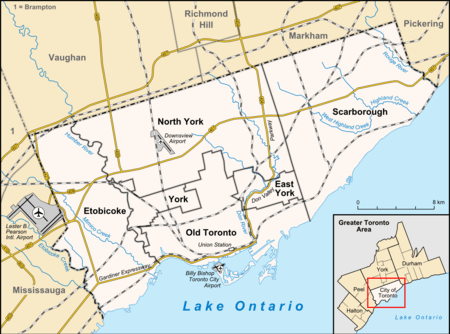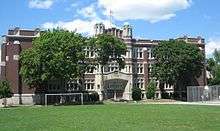Little Italy, Toronto
Little Italy, sometimes referred to as College Street West, is a district in Toronto, Ontario, Canada. It is known for its Italian Canadian restaurants and businesses. There is also a significant Latin-Canadian and Portuguese-Canadian community in the area. The district is centred on a restaurant/bar/shopping strip along College Street, centred on College Street, imprecisely between Harbord Street and Dundas Street, and spreading out east and west between Bathurst Street and Ossington Avenue. It is contained within the larger city-recognized neighbourhood of Palmerston-Little Italy.
Little Italy | |
|---|---|
Neighbourhood | |
.jpg) Street view of Little Italy from Beatrice and College Street | |
Approximate Little Italy boundaries | |
 Location within Toronto | |
| Coordinates: 43.655°N 79.413°W | |
| Country | |
| Province | |
| City | |
History
College Street was fully laid out in the area by 1900 and the area was filled with buildings from the early 1900s. College Street is fronted by two- and three-storey buildings, with commercial uses on the ground floor and residential or storage uses on the upper floors.
Italians arrived in Toronto in large numbers during the early 20th century. Italians first settled in an area then known as The Ward, centred on University Avenue and College Street.[1] Approximately 40,000 Italians came to Canada during the interwar period of 1914 to 1918, predominantly from southern Italy where an economic depression and overpopulation had left many families in poverty.[2] Son to Italian immigrants, Johnny Lombardi was born in The Ward in 1915, and went on to found one of the first multilingual radio stations in Canada, CHIN in 1966, in Palmerston–Little Italy.[3][4] By the 1920s, most Italians had moved west of Bathurst Street and the College-Clinton area had emerged as the city's major Little Italy.[1][5] They mainly immigrated to Toronto—increasing from 4,900 Italians in 1911, to 9,000 in 1921, constituting almost two percent of Toronto's population.[5]
A tourist attraction of the area is the Italian Walk of Fame. Granite and brass stars line the sidewalk with the names of noteworthy Italian Canadians. At Clinton Street, on the north side, is the Royal Cinema, which was recently renovated and has an upgraded projection system as it is used for movie editing purposes during the day and repertory cinema in the evenings. While the commercial units are dominated by cafes and restaurants, there are numerous other small businesses serving the neighbourhood.
The side streets are mostly detached or semi-detached single family homes dating to the early-1900s Edwardian period, with front porches and smaller lots, as was the custom at the time.
As early as 1961, the presence of new immigrants had already started changing Little Italy.[6] That year, 15,000 Italians, 12,000 being immigrants, lived in Little Italy (35 percent of the population), declining to 8,000 in 1971, and further to 3,600 in 1991 (13 percent of the population).[6] Since the 1970s, Italian immigrants from Little Italy moved northward to Corso Italia on St. Clair Avenue West.[6] Much of the Italian population subsequently moved to the suburbs northwest of Toronto, in particular, Vaughan, King, and Caledon.[7] Although the character of the neighbourhood is still has several Italian restaurants and bakeries, the demographics of this neighbourhood have changed drastically with a smaller Italian population than originally.
Landmarks

- Italian Walk of Fame
- Church of St. Mary Magdalene
- Church of St. Francis of Assisi
- College Street United Church
- El Convento Rico Night Club
- Mod Club Theatre
- Lily Lounge
- The Orbit Room
- Weldon Park
- Portuguese Seventh-day Adventist Church
Education

Secular English-oriented public schools in Little Italy, including Palmerston–Little Italy, are operated by the Toronto District School Board. In addition to the Toronto District School Board, three other publicly funded school boards operate in Toronto. The publicly funded English-oriented separate schools in Toronto are operated by the Toronto Catholic District School Board. Secular French-oriented public schools are provided by Conseil scolaire Viamonde, whereas French-oriented public separate school are provided by Conseil scolaire catholique MonAvenir. However, the latter three school boards do not operate a school in the neighbourhood. Public schools in the area include:
- Central Commerce Collegiate is located on Shaw Street, built in 1916.
- Harbord Collegiate Institute is located on Harbord Street, built in 1892.
In popular culture
Television and film productions are occasionally filmed in the neighbourhood. Movies filmed nearby include Chloe, Police Academy,[8] Scott Pilgrim vs. the World, The F Word, and The Long Kiss Goodnight. In December 2013 and 2014 the TV series Beauty & the Beast decorated the corner of College St. and Markham St. with a New York City Subway entrance, emergency vehicles, and newspaper stands.[9]
A 2018 romantic comedy titled Little Italy takes place in Toronto's Little Italy. The film was also featured on an episode of How Did This Get Made?
See also
- List of neighbourhoods in Toronto
- Corso Italia, Toronto
- Italians in Toronto
References
- De Kerck, Denis; Paina, Corrado, eds. (2006). College Street, Little Italy: Toronto's Renaissance Strip. Toronto, Ontario: Mansfield Press. ISBN 1-894469-27-5.
- Zucchi, p. 36.
- "History - Pier 21". www.pier21.ca.
- "Media legend Johnny Lombardi dies at 86". CTV News. March 19, 2002. Archived from the original on December 4, 2005. Retrieved April 11, 2010.
Prime Minister Jean Chretien praised Lombardi's accomplishments upon hearing of his death. "I think he's done a lot to establish multiculturalism in Toronto and he will be missed by a lot of people," Chretien said.
- User, Super. "Johnny Lombardi". www.chinradio.com.
- Sturino, Franc (1990). Forging the chain: a case study of Italian migration to North America, 2000-1930. Toronto: Multicultural History Society of Ontario. p. 168. ISBN 0-919045-45-6.
- Jordan Stanger-Ross (2010). Staying Italian: Urban Change and Ethnic Life in Postwar Toronto and Philadelphia (Historical Studies of Urban America). University of Chicago Press. ISBN 9780226770765.
- "The littlest Little Italy slowly fades away". theglobeandmail.com. August 26, 2005.
- "Awesome Movies Filmed in Toronto". Archived from the original on August 6, 2015. Retrieved January 26, 2015.
- Burpee, Matthew. "We're now in New York City". Retrieved December 12, 2013.
| Wikimedia Commons has media related to Little Italy, Toronto. |